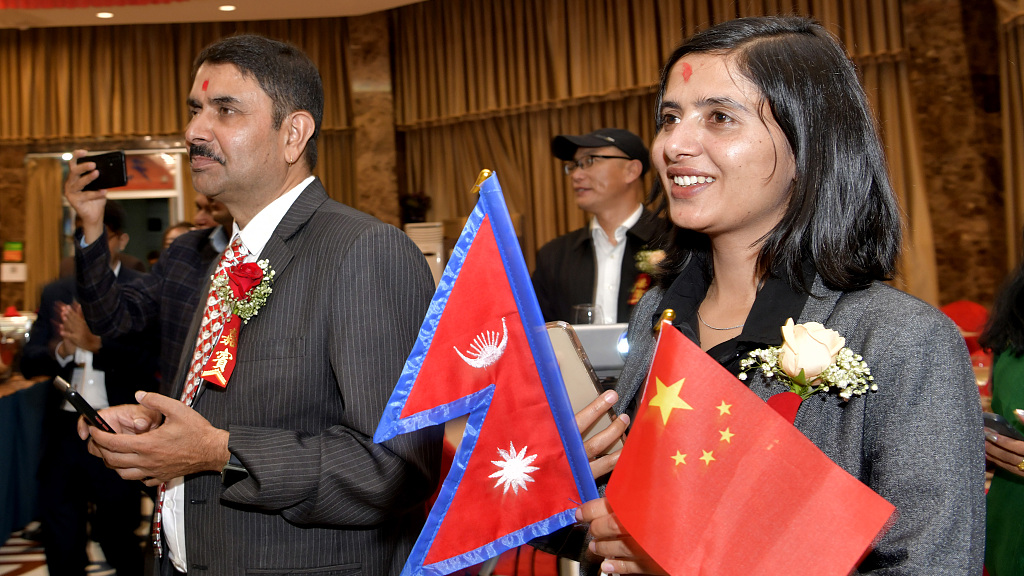
A Nepalese attendee holds Chinese and Nepalese flags at a bilateral social event in Lhasa, southwest China's Xizang Autonomous Region, October 7, 2023. /CFP
A Nepalese attendee holds Chinese and Nepalese flags at a bilateral social event in Lhasa, southwest China's Xizang Autonomous Region, October 7, 2023. /CFP
Editor's note: Leela Mani Paudyal, a special commentator on current affairs for CGTN, is a former Ambassador of Nepal to China. The article reflects the author's opinions and not necessarily the views of CGTN.
This year marks a decade of the implementation of the Belt and Road Initiative (BRI) proposed by Chinese President Xi Jinping in 2013. The third Belt and Road Forum for International Cooperation was held in Beijing from October 17 to 18. This is an appropriate time to reflect on the Belt and Road cooperation with reference to Nepal.
The BRI is a connectivity-driven development initiative in which the Chinese government aims to build the Silk Road Economic Belt and the 21st Century Maritime Silk Road across the globe. The proposal aims to promote investment, trade, cultural exchanges, and people-to-people connectivity among BRI partner countries.
China initiated negotiations with various countries and international organizations to encourage their participation in the initiative, resulting in more than 150 countries signing a memorandum of understanding (MoU) on BRI cooperation. The proposal gained global resonance after its announcement, receiving mostly positive responses from developing countries.
In 2015, the Asian Infrastructure Investment Bank (AIIB) was established as a multilateral bank with a 30 percent equity share from China. It serves as a financing window for the BRI, focusing on infrastructure financing in Asia.
Nepal signed a MoU on the Belt and Road Initiative in 2017. While signing the MoU, Nepal considered the Belt and Road Initiative as an opportunity for development financing. Nepal heavily relies on foreign funding for its development financing, as revenue hardly meets recurrent expenditures and financial management (interest and repayment of outstanding loans).
Both China and Nepal have been emphasizing and reiterating their commitments to expedite the implementation of agreements as envisioned in the Belt and Road Initiative in every successive high-level visit after 2017, including the recent visit of Prime Minister Pushpa Kamal Dahal Prachanda in September 2023. The agreements signed in recent years include the development of connectivity such as ports, roads, railways, airports, and communication networks under the broader framework of the Trans-Himalayan Multi-dimensional Connectivity Network as agreed in the high-level visits.
Economic cooperation and people-to-people exchanges between China and Nepal have significantly increased since 2017 with economic indicators showing rapid growth. China has also become Nepal's largest source of foreign direct investment, the second-largest source of tourists, and the second-largest trading partner before the COVID-19 pandemic.

Visitors purchase Nepalese sandalwood at the booth of Nepal in the Belt and Road International Pavilion of China-ASEAN Expo in Nanning, capital of south China's Guangxi Zhuang Autonomous Region, September 16, 2022. /CFP
Visitors purchase Nepalese sandalwood at the booth of Nepal in the Belt and Road International Pavilion of China-ASEAN Expo in Nanning, capital of south China's Guangxi Zhuang Autonomous Region, September 16, 2022. /CFP
In terms of air connectivity, 95 flights per week have available between the two countries since 2019, an increase from 56 flights per week. There is an understanding to expedite the construction of cross-border electrical transmission lines during Prime Minister Dahal's recent visit to China.
Recently, conflicting statements between Chinese and Nepali authorities were exposed publicly about whether the Pokhara International Airport falls under BRI or not. Some Western politicians and media have been publishing articles and suggesting Nepal not to become a part of the BRI, which they claim as a debt trap strategy. Such views would confuse the general public of Nepal who cannot analyze the facts themselves.
In such circumstances, Chinese researchers and intellectuals should come forward with factual evidence that deplores unfounded allegations of the BRI as a debt trap strategy. They have to open up dialogue with Nepali intellectuals, researchers and academicians and substantiate that the BRI is an alternative development financing window for developing countries like Nepal with win-win cooperation.
There is a need for more deliberations, conduction of independent research and exchanges of views among policy makers and intellectuals between China and Nepal about the procedures of funding and impacts of the BRI-related projects. Such deliberations and research can provide solid facts to the decision-makers who can make well-informed decisions. Intellectual discourses and joint research would help the general public understand the true perspective of cooperation under the BRI.
China has to prove through action that financing through the BRI is less cumbersome, more competitive, and more effective in terms of benefiting partner countries than the existing multilateral development financing windows.
The declared objective of the BRI is connectivity, which is of utmost significance for landlocked countries like Nepal. Nepal is heavily relying on India for economic activities and transit for international trade. Over-reliance on a single country leaves a nation vulnerable.
Nepal would not be able to realize the full advantage of transit facilities, will not be able to link with the industrial value chain of China and can't diversify the trade in the absence of cross-border railway. The cross-border railway could be the most important project to open up new avenues of opportunities for Nepal in order to diversify international trade, fully utilize the transit facilities from China, and effectively integrate the Nepali industry with China's industrial value chain.
The third Belt and Road Forum for International Cooperation is an opportunity for Nepal and China to reaffirm their commitments to engage in all the established mechanisms, identify areas for win-win cooperation, and ensure timely implementation of the agreements and projects. They should continue high-level political dialogue, build mutual trust, enhance multilateral cooperation, and contribute to prosperity, peace, and harmony within and beyond their regions.
(If you want to contribute and have specific expertise, please contact us at opinions@cgtn.com. Follow @thouse_opinions on Twitter to discover the latest commentaries in the CGTN Opinion Section.)